Do Gutter Guards Really Work? Your Comprehensive Guide to Cleaner Gutters
The dreaded task of cleaning gutters. If you’re a homeowner, you’re probably all too familiar with lugging out a ladder, scooping out slimy leaves, and dealing with the mess. It’s not just tedious; it can be dangerous. Many homeowners ask themselves, “Do gutter guards work?” and whether this seemingly simple solution can genuinely save them time, money, and hassle. This comprehensive guide is designed to answer all your questions and help you make an informed decision.
We’ll dive deep into what gutter guards are, precisely how they function, and if they truly live up to their promise as a worthwhile home improvement investment. You’ll gain insights into the various types available on the market, understand their typical costs, explore your installation options (DIY vs. professional), and weigh the pros and cons of each approach. By the time you finish reading, you’ll possess all the essential information needed to confidently decide if gutter guards are the right choice for protecting your home and simplifying your outdoor maintenance.
Understanding Gutter Guards: How They Protect Your Home
At their core, gutter guards are protective covers or inserts designed to prevent unwanted debris like leaves, twigs, shingle grit, and pine needles from entering and clogging your gutters. While effectively blocking solid materials, they are engineered to allow rainwater to flow freely into the gutter system and down the downspouts. This ingenious design maintains clear waterways, ensuring your home’s drainage system functions efficiently, rain or shine.
The basic principle behind most gutter guards involves creating a barrier over the gutter trough. This barrier features small openings, perforations, or a specific design that leverages surface tension, allowing water molecules to pass through while larger debris is shed or repelled. By maintaining an unobstructed path for water, gutter guards significantly reduce the risk of overflows and the array of problems that come with them.
Key Benefits of Installing Gutter Guards
Investing in gutter guards offers a multitude of long-term benefits that extend far beyond simply reducing a chore. They contribute significantly to the health and longevity of your home. Here’s a detailed look at the advantages:
- Drastically Reduced Gutter Cleaning and Maintenance: This is often the primary motivation for most homeowners. Gutter guards prevent the vast majority of debris from accumulating, meaning you’ll spend less time on a ladder and more time enjoying your weekends. While not entirely maintenance-free (some guards may need occasional brushing), the frequency and difficulty of cleaning are dramatically reduced. This is especially valuable for homes surrounded by mature trees that shed a lot of leaves or needles.
- Robust Protection Against Water Damage: Clogged gutters are a leading cause of costly water damage. When water can’t flow through your gutters, it overflows, often cascading down your home’s exterior. This can lead to:
- Foundation Damage: Water pooling around the foundation can seep into cracks, causing structural issues and basement flooding.
- Fascia and Soffit Rot: Constant exposure to overflowing water can rot the wooden components of your roofline, leading to expensive repairs and potential pest entry points.
- Landscape Erosion: Uncontrolled runoff can wash away topsoil, damage plants, and create unsightly trenches in your garden.
- Siding Damage: Water constantly running down siding can stain, warp, or encourage mold and mildew growth.
Gutter guards ensure proper water diversion, safeguarding these critical areas.
- Extended Gutter System Lifespan: Debris accumulation isn’t just about blockages; it also traps moisture. This constant dampness, combined with organic matter, can accelerate rust and corrosion in metal gutters and degrade plastic ones. By keeping gutters clear and dry, guards help preserve the integrity of your existing gutter system, preventing premature deterioration and the need for expensive repairs or full replacements. This protects your initial investment in your gutters.
- Pest Deterrence: Clogged gutters filled with damp leaves and standing water create an ideal breeding ground and habitat for various pests, including mosquitoes, wasps, birds, rodents, and even termites. Gutter guards act as a physical barrier, making your gutters less attractive to these unwelcome visitors, thus contributing to a healthier home environment.
- Reduced Risk of Ice Dams: While not a complete solution, effective gutter guards can help mitigate the formation of ice dams in colder climates. By keeping gutters clear, they allow melting snow to drain properly rather than pooling and refreezing, which can lead to ice dams that damage roofs and gutters.
Clearly, gutter guards offer compelling, long-term advantages that extend well beyond mere convenience, contributing significantly to your home’s structural health, aesthetic appeal, and overall value.
Step-by-Step Guide to DIY Gutter Guard Installation
For the handy homeowner, installing gutter guards yourself can be a rewarding and cost-effective project. Follow these detailed steps to ensure a proper and effective installation that provides lasting protection for your home. Remember, safety is paramount when working at heights.
Tools and Materials Required
Before you begin, gather all necessary tools and materials. Having everything on hand will make the process smoother, safer, and more efficient:
- Gutter Guards: Choose the type best suited for your home and debris.
- Drill and Hex Head Driver (1/4-inch): For securing guards, if screws are needed.
- Metal Cutters or Tin Snips: Essential for cutting guards to length and around corners.
- Screws: Specific to your gutter guard type and gutter material (often included with guards).
- Tool Belt: To keep essential tools easily accessible while on the ladder.
- Heavy-Duty Gloves (Nitro-coated for protection and grip): Protect your hands from sharp edges and debris.
- Bucket: For collecting debris during cleaning.
- Sturdy Ladder: Ensure it’s tall enough and stable on level ground.
- Gutter Scoop or Trowel: For manual debris removal.
- Leaf Blower (optional but recommended): For quick initial clearing.
- Caulk Gun and Exterior-Grade Silicone Sealant: For repairing any cracks or leaks found during inspection.
- Safety Glasses: To protect your eyes from debris.
- Cougar Paws (or similar roofing shoes): If you need to work on the roof, these provide excellent grip.
Step 1: Thoroughly Clean the Gutters
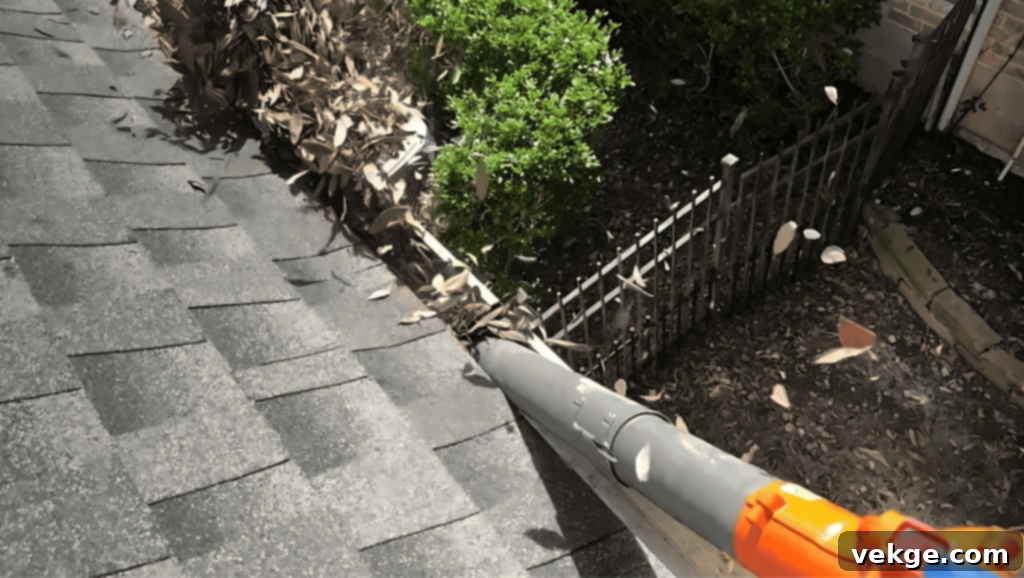
This is a critical first step. Gutter guards are meant to *prevent* clogs, not fix existing ones. Use a powerful leaf blower to clear loose debris. For stubborn, wet, or compacted clogs, employ a gutter scoop or even your gloved hands to meticulously remove all leaves, dirt, shingle grit, and anything else that might impede water flow. Pay special attention to downspout openings. A perfectly clean gutter ensures the guards can perform their job efficiently and prevents immediate blockages from compromising your new system.
Step 2: Inspect and Repair the Gutter System
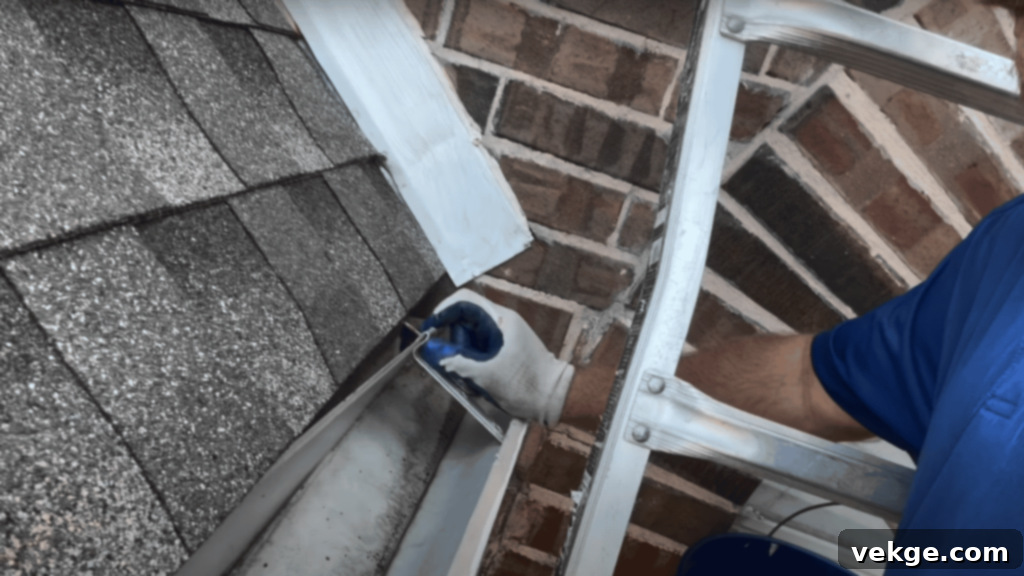
Before covering your gutters, it’s essential to ensure they are in optimal condition. Carefully inspect the entire length of your gutters and downspouts for any signs of damage: cracks, holes, loose hangers, sagging sections, or leaky seams. Use exterior-grade silicone sealant to seal any small cracks or gaps. Re-secure loose sections or replace damaged hangers. Addressing these issues now will prevent future leaks and costly water damage, ensuring your gutter guard system operates at peak efficiency.
Step 3: Measure and Cut the Gutter Guards

Accuracy is key here. Measure the precise length of each gutter section where guards will be installed. Using your metal cutters or tin snips, carefully cut the gutter guards to these exact dimensions. For external corners, make a precise 45-degree angle cut on two pieces that will meet to create a seamless, tight fit. For internal corners, you might need to overlap or create custom cuts depending on your specific guard type. A proper fit ensures maximum debris blockage and a professional appearance.
Step 4: Install the Gutter Guards
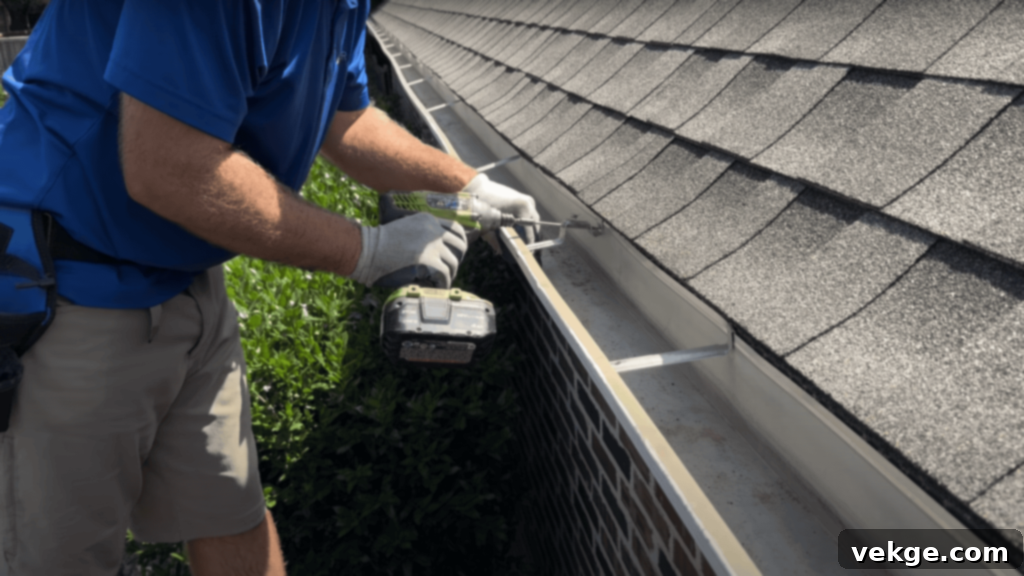
Begin installing the guards at one end of a gutter section. For many types, you’ll gently slide the back edge of the guard underneath the first row of shingles on your roof. The front edge then typically clips onto the lip of the gutter, or is secured with an adhesive strip. Depending on the guard design and manufacturer instructions, you may need to use a drill and screws to further secure the guards, especially at the ends of sections or where they meet corners. Ensure each guard is seated snugly and provides full coverage across the gutter opening. Do not over-tighten screws, as this can damage the gutter.
Step 5: Handle Special Sections and Final Checks
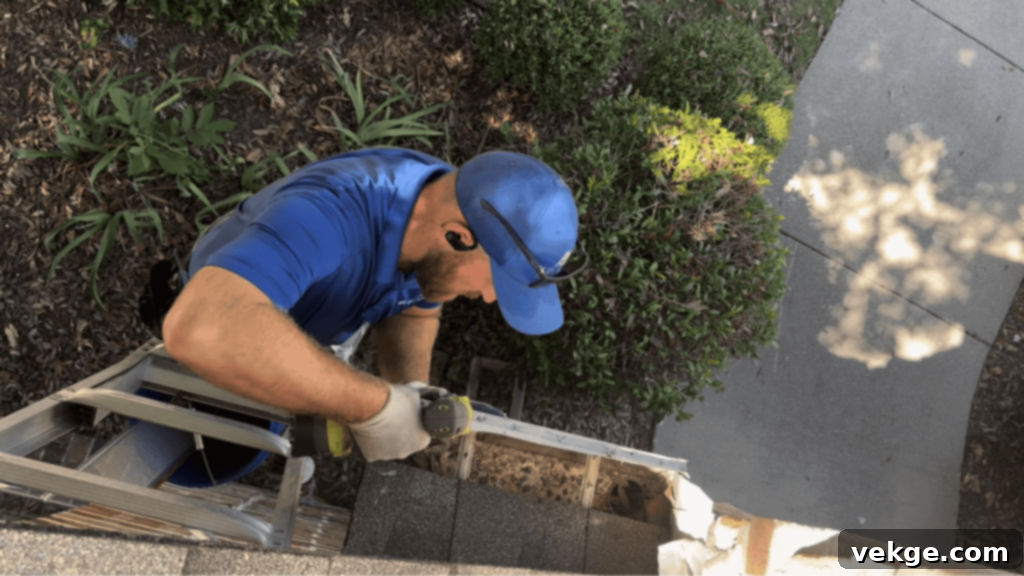
If your home features rain diverters, splash guards, or other accessories, you may need to temporarily remove them during installation. Once the gutter guards are securely in place, reattach any such components, ensuring they fit properly over or around the new guards and continue to direct water effectively. Finally, take a step back and visually inspect your entire installation. Look for any gaps, loose sections, or areas where debris could still potentially enter. A final check ensures complete coverage and peace of mind.
Pros and Cons of Gutter Guards: A Balanced View
While gutter guards offer significant advantages, it’s crucial for homeowners to consider both their benefits and potential drawbacks. Understanding these factors will help you determine if they align with your expectations and budget.
Here’s a detailed comparison of the advantages and disadvantages:
| Pros of Gutter Guards | Cons of Gutter Guards |
|---|---|
| Significantly Reduced Gutter Cleaning: The primary benefit, saving immense time and effort, especially for homes with many trees. This often justifies the investment alone. | Not Completely Maintenance-Free: While reducing frequent cleaning, some guards may still accumulate small debris, pollen, or shingle grit on their surface, requiring occasional rinsing or brushing. |
| Protection from Costly Water Damage: Ensures proper water flow away from your home, preventing foundation issues, fascia rot, basement flooding, and landscape erosion. | Potential for “Overshooting” in Heavy Rain: Some gutter guard designs, particularly those that rely on surface tension, can cause water to cascade over the gutters during exceptionally heavy downpours if the flow rate exceeds the guard’s capacity. |
| Extended Gutter System Lifespan: By keeping gutters free of debris and stagnant moisture, guards prevent rust, corrosion, and deterioration, prolonging the life of your existing gutters. | Limited Effectiveness with Certain Debris: Very fine debris, like pine needles, seeds, or fine shingle grit, can sometimes slip through mesh or get stuck in bristles, potentially leading to minor clogs over time, or requiring surface cleaning. |
| Pest Deterrence: Blocks leaves and standing water that attract mosquitoes, rodents, birds, and other pests from nesting in your gutters. | High Initial Investment Costs: High-quality gutter guards, especially micro-mesh or solid aluminum systems with professional installation, can represent a substantial upfront expense. |
| Fire Safety (in some regions): In areas prone to wildfires, some non-combustible gutter guards can prevent embers from collecting in dry leaf debris within gutters, reducing a potential fire hazard. | Aesthetic Impact: Some gutter guard types can alter the visible appearance of your gutters, which might be a concern for homeowners particular about curb appeal. |
| Enhanced Home Value: As a protective and low-maintenance feature, gutter guards can be an attractive selling point, potentially increasing your home’s market value. | Installation Can Void Roof Warranty: Improper installation, especially if guards are secured by lifting shingles, might void certain roof warranties. Always check with your roofing manufacturer. |
Ultimately, while gutter guards can be a fantastic solution for reducing maintenance and protecting your home, they come with considerations. It’s essential to evaluate these factors against your specific home, environment (e.g., type of trees), budget, and tolerance for minor maintenance to determine if they are the right fit for your needs.
Exploring the Different Types of Gutter Guards
The market offers a diverse range of gutter guard designs, each with its unique materials, mechanisms, and ideal applications. Understanding these types will empower you to select the best option that matches your specific debris challenges, budget, and desired level of performance.
1. Mesh Gutter Guards
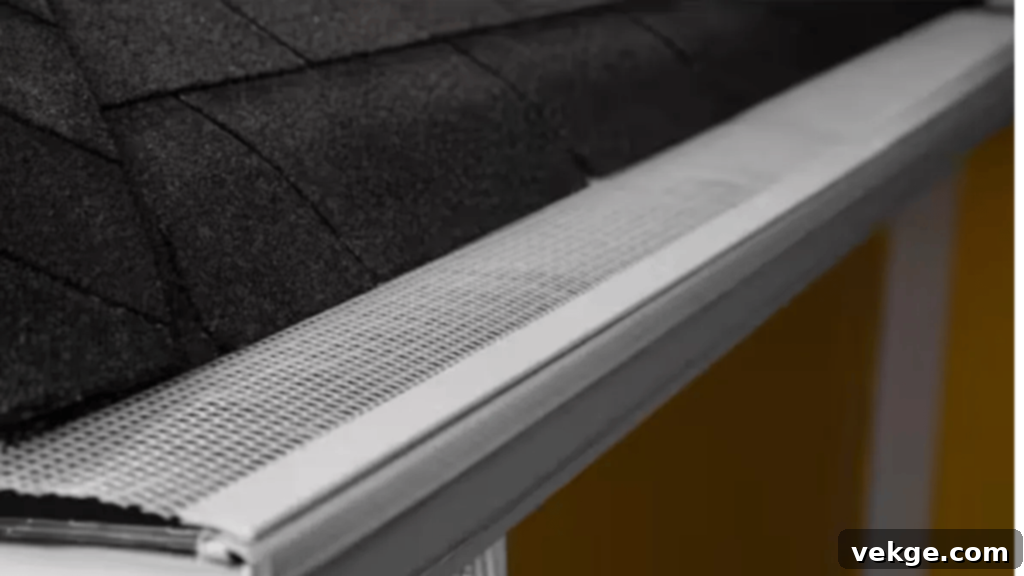
Mesh gutter guards feature a fine, tightly woven screen, typically made from stainless steel or aluminum, stretched across a frame. Their tiny perforations are excellent at blocking even small debris like pine needles, seeds, and shingle grit, while still allowing rainwater to pass through. They are highly effective in areas with dense tree coverage and can be very durable, resisting rust and corrosion. However, their fine mesh can sometimes accumulate pollen or very fine grit on the surface, which might require occasional rinsing. They tend to be more expensive than simpler screen guards, particularly high-quality micro-mesh varieties that offer superior filtration and durability.
2. Screen Gutter Guards
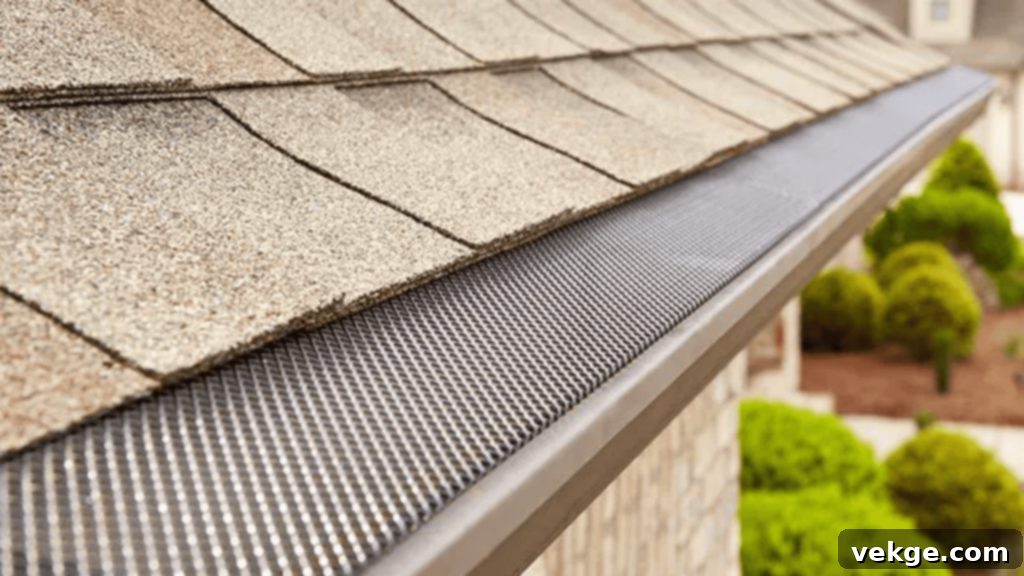
Screen gutter guards are among the most basic and widely available types. They typically consist of a perforated metal or plastic sheet that fits over the top of the gutter. Their primary function is to block larger debris like leaves and twigs, allowing water to pass through the openings. These guards are generally very affordable and straightforward for DIY installation, often clipping or sliding into place. However, their larger openings mean they are less effective against smaller debris such as pine needles, seeds, and shingle grit, which can still enter and accumulate in the gutter, potentially causing partial blockages over time.
3. Reverse-Curl Gutter Guards (Surface Tension)
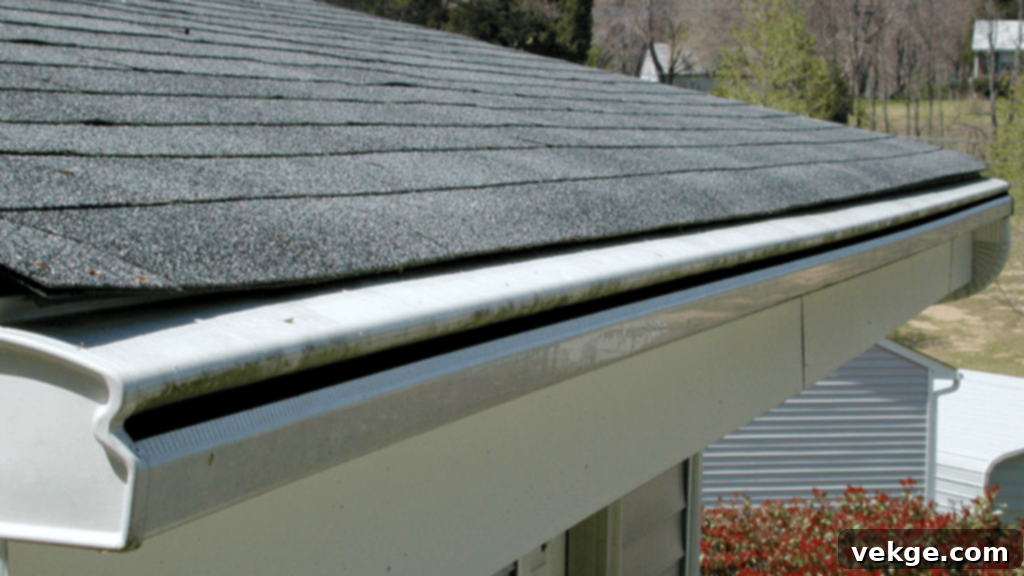
Also known as surface tension or “hooded” systems, reverse-curl gutter guards feature a solid top surface that extends over the gutter, with a small opening or lip along the front edge. They work on the principle of surface tension: rainwater adheres to the curved surface and follows it around the edge, flowing into the gutter, while leaves and debris are shed and fall harmlessly to the ground. These are highly effective at keeping virtually all solid debris out. They perform exceptionally well during heavy rainfall, handling large volumes of water without overshooting. However, they are often the most expensive option and usually require professional installation to ensure correct pitch and performance, as improper installation can lead to overshooting in heavy downpours.
4. Brush Gutter Guards
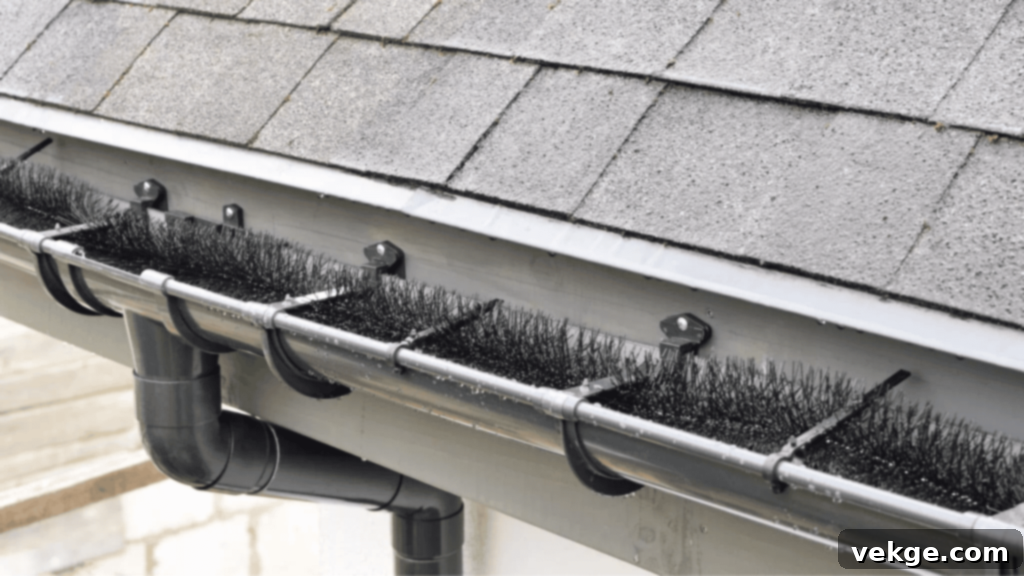
Brush gutter guards resemble an oversized bottle brush designed to fit snugly inside your gutters. The stiff bristles fill the gutter trough, blocking leaves and large debris from settling, while allowing water to filter through the brush. They are relatively inexpensive and exceptionally easy to install (you simply lay them in the gutter). However, they are generally considered less effective than other types for preventing all debris. The bristles themselves can catch and hold smaller debris, such as pine needles, seeds, and shingle grit, leading to a build-up over time that still requires occasional cleaning or removal of the brushes for maintenance. They are a good option for homes with minimal tree cover or as a temporary solution.
5. Foam Gutter Guards
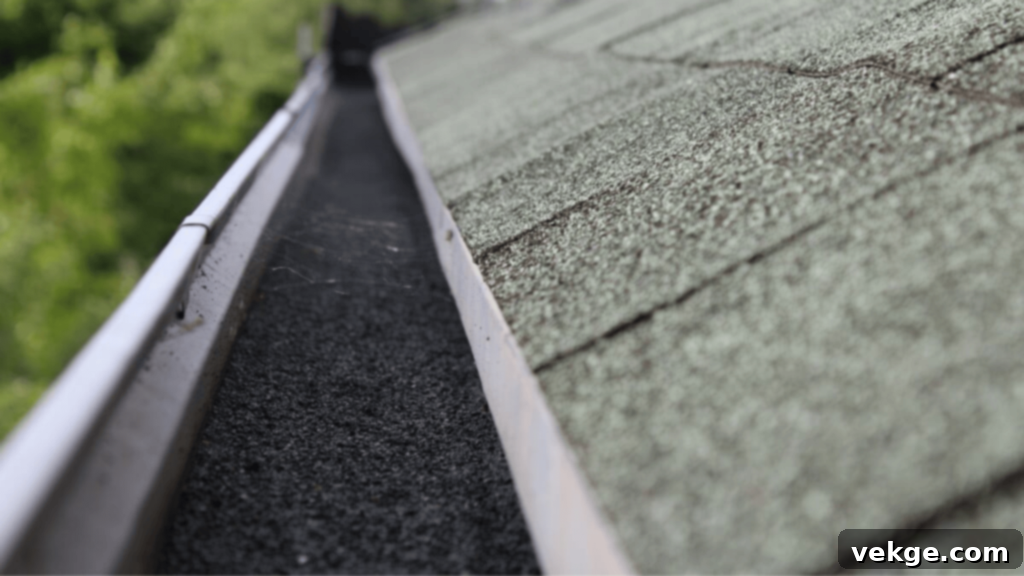
Foam gutter guards are wedge-shaped pieces of porous foam that fit directly into the gutter channel. They act as a permeable barrier, allowing water to soak through while blocking all but the finest debris from entering the gutter. Similar to brush guards, they are very easy and affordable to install, requiring no tools. However, they are generally less durable than metal options and can degrade over time due to UV exposure or harsh weather. They are also prone to accumulating fine organic matter within the foam itself, which can lead to moss or algae growth and eventually reduce water flow, requiring removal and cleaning of the foam. They are best suited for areas with light debris and mild climates.
6. Hooded Gutter Guards (A Variation of Reverse-Curl)
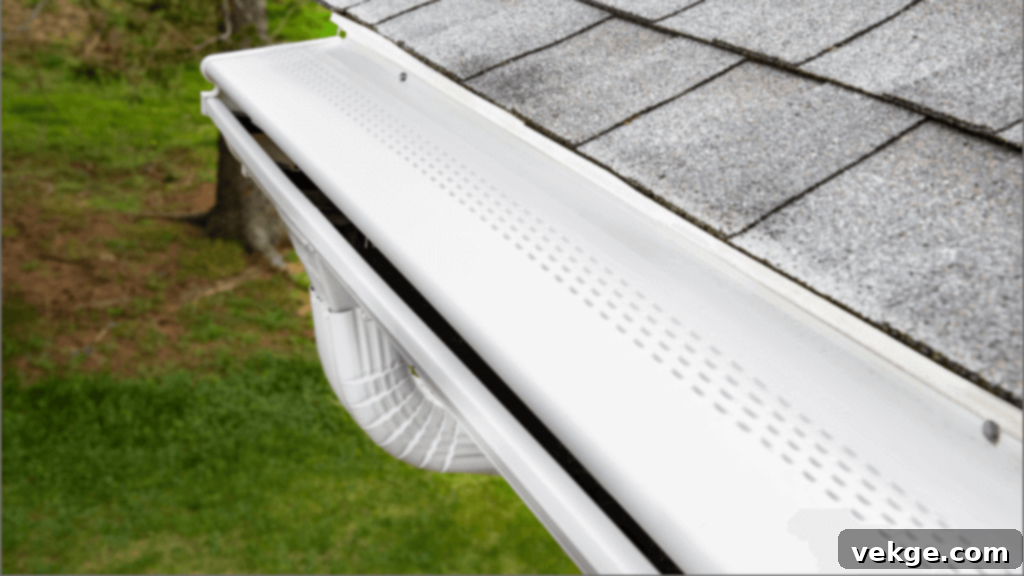
While often grouped with “reverse-curl” systems, hooded gutter guards specifically emphasize a distinct, solid covering or “hood” over the entire gutter opening. Water flows over the smooth, rounded hood and down into a narrow slot, while leaves and larger debris simply slide off. They are exceptionally effective at preventing virtually all types of large debris from entering the gutter. This design is highly robust and performs well in environments with heavy leaf fall. Like other solid-top systems, they are typically a premium product, often made from durable aluminum, and usually require professional installation to ensure the correct pitch for effective water shedding and to prevent roof warranty issues.
7. Aluminum Gutter Guards (Material-Based Category)
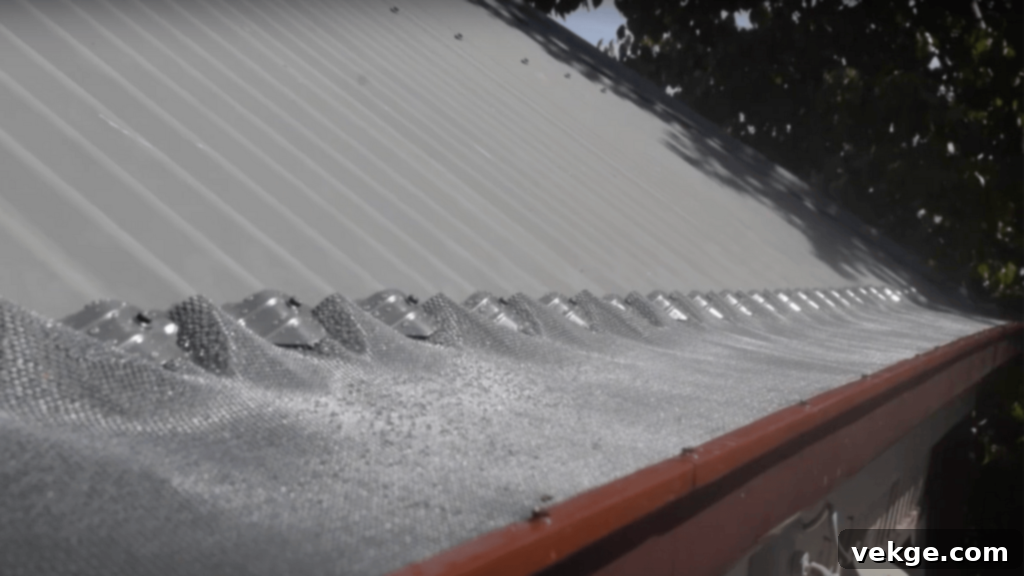
This category refers to the material rather than a specific design, as many mesh, screen, and hooded guards are made from aluminum. Aluminum is a popular choice for gutter guards due to its inherent durability, light weight, and excellent resistance to rust and corrosion, ensuring a long lifespan. It can be found in various designs, from simple perforated screens to advanced micro-mesh and reverse-curve systems. Aluminum guards are a premium option, ideal for virtually all climates and debris types, especially where longevity and robust performance are prioritized. While the material itself contributes to higher costs compared to plastic or foam, it offers superior value over time due to its resilience. Professional installation is common for higher-end aluminum systems, further increasing the overall investment.
The optimal gutter guard for your home will depend on several factors: your budget, the specific types and volume of debris your roof collects (e.g., large leaves, fine pine needles, shingle grit), the intensity of rainfall in your area, and your willingness to perform occasional surface maintenance. Carefully consider these aspects to choose the most effective and appropriate gutter protection system.
Gutter Guard Installation: DIY or Hire a Professional?
Once you’ve decided that gutter guards are right for your home, the next big question is whether to tackle the installation yourself or enlist the help of a professional. Both options have distinct advantages and disadvantages, and the best choice often depends on your skills, comfort level, and specific home circumstances.
Pros and Cons of DIY Gutter Guard Installation
Opting for a do-it-yourself installation can be an attractive proposition for many homeowners, primarily because it’s significantly more cost-effective. By purchasing the materials yourself and performing the labor, you avoid paying for professional service fees, which can quickly add up. This approach also grants you full control over the project; you can work at your own pace, choose the exact materials you prefer, and inspect every step of the installation. Successfully completing a DIY project also offers a strong sense of personal satisfaction and accomplishment, empowering you as a homeowner.
However, DIY installation comes with inherent challenges. It can be quite time-consuming, especially if you lack prior experience or the right tools. Learning the proper techniques and making precise cuts for a seamless fit takes time and patience. More importantly, there are significant safety risks involved. Working on ladders or roofs, particularly on multi-story homes or steep pitches, can lead to serious falls if not done correctly and with proper safety gear. Furthermore, improper installation can lead to potential mistakes, such as gaps that allow debris to enter, guards that lift in high winds, or even damage to your gutters or roof, ultimately costing you more in future repairs.
When to Call a Professional for Gutter Guard Installation
There are several scenarios where hiring a professional gutter guard installer is not just convenient but highly recommended for safety and optimal performance. You should consider calling an expert if:
- You’re Unfamiliar with Gutter Systems or Lack Tools: Professionals possess specialized knowledge, tools, and techniques to ensure a flawless installation.
- Your Home Has High or Complex Gutters: Multi-story homes, homes with steep roof pitches, or intricate gutter layouts present significant safety challenges and require specialized equipment that most homeowners don’t have.
- You Prefer a “Set-It-and-Forget-It” Solution: Professional installers offer expertise, often provide warranties on both the product and their labor, giving you peace of mind that the job is done right and is covered.
- You’re Installing High-End Gutter Guards: Complex systems like reverse-curl or micro-mesh often require precise installation to function correctly, which is best left to experienced professionals.
- You Want to Avoid Safety Risks: The risk of falls from ladders is substantial. If you’re uncomfortable with heights or don’t have suitable safety equipment, a pro is the safest choice.
Ultimately, while DIY installation offers cost savings and a sense of accomplishment, prioritizing safety and ensuring a quality, long-lasting installation often makes professional help the superior choice, especially for challenging homes or premium systems.
How Much Do Gutter Guards Cost? Breaking Down the Investment
The cost of gutter guards can vary significantly, influenced by factors such as the type of guard chosen, the linear footage of your gutters, the complexity of your roofline, and whether you opt for DIY installation or professional service. Here’s a general breakdown to help you budget:
DIY Gutter Guard Material Costs
If you plan to install gutter guards yourself, your primary expense will be the materials. Prices are typically quoted per linear foot:
- Most basic plastic or foam gutter guards are the most economical, ranging from $1 to $4 per linear foot. These are good for light debris and smaller budgets.
- Mid-range options like mesh and screen styles, often made from metal or durable plastic, typically cost between $2 to $5 per linear foot. These offer better debris blocking than basic foam/plastic.
- For higher-quality DIY micro-mesh or more robust aluminum screen guards, you might pay anywhere from $3 to $8 per linear foot.
For a typical home with 150 to 200 linear feet of gutters, the DIY material cost can range from a modest $150 (for basic foam/plastic) to $1,600 (for high-quality DIY mesh). Remember, this does not include tools you might need to purchase, like metal cutters or a drill, if you don’t already own them.
Professional Gutter Guard Installation Costs
Hiring professionals significantly increases the cost due to labor, specialized equipment, and often higher-grade materials. Professional installation typically includes both materials and labor in the quoted price:
- For most standard gutter guard options (e.g., quality mesh, standard hooded systems), professional installation usually costs between $7 to $15 per linear foot.
- High-end or custom gutter guards, such as premium micro-mesh systems, durable solid aluminum hooded guards, or systems requiring complex installation, can go up to $20 or even $30+ per linear foot.
For an average-sized home with 150 to 200 feet of gutters, you can expect total professional installation costs to range broadly from $1,050 to $6,000 or more, depending heavily on the specific type of guard chosen, the complexity of your roofline (e.g., multiple stories, steep pitches, many corners), and your geographic location. This price typically includes all materials, labor, and often a warranty on both the product and the installation, offering peace of mind.
When comparing costs, always consider the long-term value: a more expensive, professionally installed system might last longer, require less maintenance, and offer superior protection compared to a cheaper DIY solution.
Common Mistakes to Avoid in DIY Gutter Guard Installation
While installing gutter guards yourself can be rewarding, it’s easy for even the most enthusiastic DIYer to make mistakes that compromise their effectiveness. Being aware of these common pitfalls can help you achieve a successful and long-lasting installation:
- Not Cleaning Gutters Thoroughly Enough: This is perhaps the most frequent and critical error. Installing guards over gutters that still contain debris, mud, or standing water will quickly lead to new clogs *under* the guards. These hidden clogs can be harder to clear and negate the entire purpose of the installation. Always ensure your gutters are meticulously clean before proceeding.
- Ignoring Existing Gutter Damage: Skipping the essential step of inspecting and repairing your existing gutters (cracks, loose hangers, sagging sections, leaks) is a recipe for future problems. Gutter guards won’t fix underlying issues; they’ll only cover them up. Leaks and damage will continue, potentially causing more severe water damage to your home, and you’ll have to remove the new guards to address the old problems.
- Incorrect Measurements and Poor Cuts: Guessing or making inaccurate measurements for your gutter runs and corners will result in ill-fitting guards. Gaps between sections or at corners allow debris to enter, defeating the purpose of the guards. Poorly cut pieces can also look unprofessional and be less secure. Always measure twice and cut once with precision.
- Over-Tightening Screws or Fasteners: While you want guards to be secure, over-tightening screws into your gutters can warp the metal, strip the holes, or even crack plastic gutters. This weakens the gutter structure and can create new points of failure or leaks. Fasteners should be snug, but not overly tight.
- Not Securing the Guards Properly: Relying solely on adhesive strips or the weight of the guards, especially in areas prone to high winds or heavy snow, can lead to guards shifting, lifting, or even blowing off. Always follow manufacturer guidelines for securing the guards, using appropriate screws or clips where recommended. Inadequate securing creates gaps for debris and can lead to damage to the guards themselves.
- Impacting Roof Shingles or Voids Warranty: Some gutter guard designs require sliding under or attaching to roof shingles. If this is done incorrectly, it can lift shingles, compromise their watertight seal, and potentially void your roof’s warranty. Always understand how your chosen guard interacts with your roofline and consult your roofing manufacturer’s guidelines if unsure.
By taking your time, adhering strictly to installation instructions, and paying close attention to these common mistakes, you can ensure a much smoother DIY process and a more effective, long-lasting gutter guard system for your home.
Conclusion: Are Gutter Guards the Right Solution for You?
After exploring the ins and outs of gutter guards, it’s clear they offer a smart, proactive approach to home maintenance. This guide has provided you with a comprehensive overview of how these systems work, the diverse types available on the market, the detailed steps for DIY installation, and a balanced look at the costs and benefits of both self-installation and hiring a professional.
Gutter guards are designed to alleviate the burden of frequent gutter cleaning, protecting your home from potentially costly water damage, extending the lifespan of your gutter system, and even deterring pests. While no system is entirely maintenance-free, the reduction in effort and the enhanced protection they offer can be a significant advantage for most homeowners, especially those in leaf-heavy environments.
Now armed with all the facts, take a moment to consider your specific needs: your home’s unique characteristics, the amount and type of debris it encounters, your comfort level with DIY projects, and your budget. By carefully weighing these factors, you can confidently decide if gutter guards are the right investment for your property. They represent more than just a convenience; they’re a long-term solution for safeguarding your home and reclaiming your valuable time.
Still pondering, “Do gutter guards work for my specific setup?” Consider seeking out local reviews, requesting quotes from professional installers, and observing homes in your neighborhood to see what solutions they employ. Making an informed decision today can save you countless hours and thousands in repairs tomorrow.
